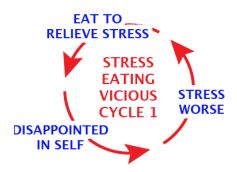 |
BlubberBusters Tips
from Lucy (Click here for past week's tips) |
|||||||||||||||||||||||||||||||||||||||||||||||||||||
A 3 WAY APPROACH TO WEIGHT LOSS - STEP ONE -ELIMINATE PROBLEM FOODSWe've broken down the process of losing weight into 3 steps: STEP ONE: Eliminate problem foods: This entails identifying all your problem foods (foods you have trouble resisting or can't stop eating once you start) and abstaining or avoiding each food, one-at-a-time, for at least 10 days each, or until your cravings and difficulty resisting the food have resolved. STEP TWO: Eliminate snacking: This is accomplished by abstinence from snacking during distinct time intervals (such as morning, afternoon, evening or nighttime) for 10 days for each time period or until difficulty resisting snacking during that time period has resolved. STEP THREE: Reduce mealtime food amounts: This consists of measuring/weighing all foods frequently eaten at meals and gradually reducing starting amounts in small increments. This step helps determine the amount of food that will be needed to maintain or further reduce your current weight.
1. WHAT IS MY MOTIVIATION. Write down in a notebook answers to the following: - How motivated am I to change my current lifestyle and my current food habits? It's a good idea to take inventory of yourself to determine your readiness. Are You Ready To Change? 
- What do I dislike about my weight. This could be things like, I can't wear cute clothes, I look bad in a bathing suit, I can't run as fast as others, etc. - What are the reasons I want to be thinner. You might want to read what kids on this site have said and their success stories. 2. WHAT IS MY STORY. Write down your story. Who are you? How did you became overweight? What is it like being overweight? What have you tried in the past? What are your struggles and goals? Write down other things about yourself: - your strengths, - things you are good at, - things you like about the way you look, - what other people like about you, - things you are thankful for in life, - nice things you have done for others, - what you may do to improve yourself. 3. WHAT ARE MY COPING SKILLS AND STRESS REDUCTION METHODS. - Keep a food/emotion diary for a few days or longer. This will help you see what and how much you are eating and when you eat. Are you eating when you are sad or bored? A diary helps you get in touch with what you are doing. - Write down your problems or worries on a list and write a plan out for each problem or worry. For example: - Problem: I'm worried about my math test. - Plan: Get help from Mrs. Wright, my math teacher or my friend Susie who is a wiz in math. 4. WHO ARE MY SUPPORT PEOPLE. 5. WHAT DISTRACTIONS CAN I USE. Make a list of activities and distractions you enjoy that you can do instead of eat. Then, when you feel like eating when you aren't even hungry, pick one of your distractions instead. 6. 7. WHAT ARE MY STRUGGLE POINTS. (what do I have the most difficulty avoiding) such as: - problem foods, - snacking/grazing between meals, - excessive food amounts at meals, - comfort/stress eating and bingeing, - eating out at restaurants, fast food outlets, and so forth. If we know what our struggle points are, we can make a plan ahead of time to avoid it. For example, if I know when I eat out that I always eat huge amounts, make a plan to cut your meal in half and put in a "TO GO" box BEFORE you start eating. Or, limit going out to eat. 8. HAVE I MADE MY HOUSE FOOD SAFE - Make an assessment of the food in your house. Write down a plan to make it food safe. For example: Put the sodas in the garage, put any sweets in the highest cupboard or don't have any in the house, things like that. 
- Make a grocery list with the person who buys the food. Don't buy junk food or food you have trouble resisting. Or, make a plan to put it out of your site so you aren't tempted. - Grocery shop with the person that buys the food. Limit buying junk food. - Make a plan ahead of time. Then, when you are tempted, follow your plan.
STEP ONE: ELIMINATE PROBLEM FOODS 1. Identify and list all of your problem foods. List all the foods you currently have trouble resisting or can't stop eating once you start. This might be soda, chips, chocolate, cheese, cookies. 2. List your triggers, (events or cues that cause you to feel certain urges to eat your problem food when you aren't hungry). For example: When I walk past the bakery on my way home from school I can't resist going in to buy a cookie. Walking past the bakery is your trigger. 3. Write a plan to avoid your problem food triggers. In the above example, walking past the bakery is your trigger. Your plan could be to take a different route home so you don't pass by the bakery and buy a cookie. 4. Withdraw from one or two problem foods at a time. Pick one or two of your problem foods on your list to start avoiding. Write down the problem food item you are going to avoid in your notebook. CHECK IN EVERY DAY and check off whether you avoided the problem food or did not during that day. Check off if you still have cravings and/or difficulty resisting the food. Once you have been able to not eat the food for at least 10 days in A ROW and no longer have either cravings or difficulty resisting that food, you can label that problem food as "In Control." Congratulations!! Click here to print out the below Problem Food Elimination chart and use one for each problem food.
5. Proceed to withdraw from the next problem food on your list in the same manner. This process should be repeated until all problem foods are in control. This may take several weeks so BE PATIENT. YOU CAN DO IT!!
6. Now that you have all your problem foods in control, you are now ready to go on to STEP TWO: ELIMINATE SNACKING. CONGRATULATIONS!!!! Let us know what you think of this tip. Make this a healthy week! (Click here for past week's tips) |
||||||||||||||||||||||||||||||||||||||||||||||||||||||
Please ask your
healthcare provider if these tips are right for you and please read our disclaimer.
 Write down a list of your support people. These are people you might call when you are struggling or need some encouragement.
They might be family members, certain friends, a teacher, or other support persons in your life.
Write down a list of your support people. These are people you might call when you are struggling or need some encouragement.
They might be family members, certain friends, a teacher, or other support persons in your life. WHAT
WHAT